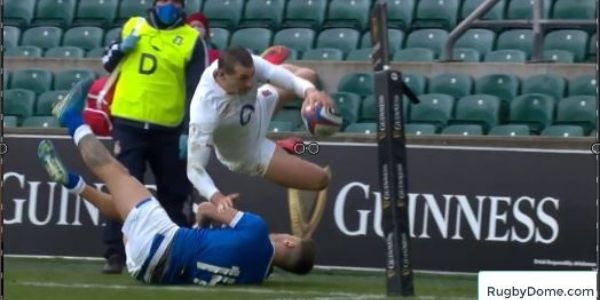Rugby Union has more ways of scoring points than many ball sports. In the early days, the only method of scoring was to kick a goal.
That has greatly changed in the modern game.
Five Ways To Score Tries
There are five ways to score in Rugby Union. Points can be kicked through a penalty goal, a drop goal, or a try conversion.
A fourth way to score is through a try in open play.
The fifth way is to be awarded a penalty try if the referee decides that an infringement prevented a probable try.
There are further complications with each method of scoring. Let’s run through them all, and look at some of the more unusual aspects.
Ways To Score Tries In Rugby

The classic sight in rugby is a winger diving over the line to ground the ball for a try.
One-handed or two-handed, it doesn’t matter as long as their fingers are on the ball when it touches grass in the in-goal area.
If you want to know more about these spectacular scores, check out our article on why players dive to touch down.
Does the player have to cross the line?
But what if the attacker is tackled before they run over the try line?
What if they don’t get their whole body across the line? And what if they’re on their back?
No problem, that’s a try. Of course, it takes considerable skill. Have a look at this international cracker from Ireland touring Australia in 2008. It’s a team try, finished by Irish captain Brian O’Driscoll.
Does the ball have to touch the ground for a try?
There are very limited exceptions when the ball doesn’t have to hit the ground for a try to be awarded.
The base of the posts is considered a scoring area. This is most often taken advantage of by forwards when they have set up a ruck near the posts.
If a forward can touch the ball against the padding at the base of the posts, a try is awarded.
The defenders will try to knock the ball away, but it is still a score if the referee sees that contact was made with the post.
By the way, there’s very good reason why the posts are padded.
In this example, two players are chasing a kick forward. They dive to reach the ball as it crosses the line. The attacking winger actually fumbles the ball and crashes into the post.
If he’d held onto the ball and hit it into the post – before he hit the post himself – it would have been a try!
Does the attacker have to be in the field of play to score a try?
Let’s say an attacking player is chasing a ball as it crosses the line and when he dives, he misses the ball and slides out over the back of the in-goal area.
He’s now off the field of play. What if the ball rolled to a stop without going out? Can the player run back and ground the ball?
Yes, he can. As long as he wasn’t holding the ball when he went out of play, he’s fine. Of course, if he was holding the ball – he’s taken it out of play, and possession is returned to the opposition.
Some more unlikely scenarios
I remember watching a match during a Lions tour of South Africa with a rabbit running around the pitch. And in club matches, it’s not unknown for a dog to wander across the field.
What happens if an animal gets in the way of a player about to score a try? Suppose the ball is kicked forward and the winger is “haring” after it with no defender near him.
And just before he’s about to fall onto the ball in the in-goal area, the rabbit has nudged it out of his way!
Or perhaps a little less fanciful, the dog has grabbed the ball between its jaws and ran off with it.
And far more likely, a toddler has broken free from a parent on the sidelines and has excitedly picked up the ball.
You may think that’s hard cheese for the attacking team, but no.
If the ball hits a “non-player” and the referee decides a try would otherwise probably have been scored, the try can be awarded.
Ways To Kick Points In Rugby
Players can score in rugby through kicking penalties, drop goals, and conversions. The only rule is that the ball must pass between the posts.
What if the ball sails above the height of the posts?
This is why two match officials stand behind each post and look upward. They must judge whether the ball passes inside an imaginary line going past the top of the post.
Each official raises a flag to show that the ball has passed “inside” the post. Both flags up mean that the points are scored, no matter how high the ball reached.
What if a stiff wind blows the ball back through the posts?
As long as the ball goes through the posts, what happens next doesn’t matter.
I’ve seen this scenario at a club match. The unusual scenario was made more likely by the penalty kick being taken right at the side of the pitch. Our kicker had to curl the ball toward the posts.
Of course, this means the ball is traveling with less force than a kick straight in front of the posts.
A gust of wind pushed the ball back through the posts and it bounced into the playing area.
When the points were awarded, I pretended I knew all along that this was the rule!
Scoring Through Penalty Tries

I’ve heard people say that there are only four ways to score. They are usually forgetting the penalty try.
The penalty try is awarded when the referee judges that an infringement by the opposition stopped a probable try from being scored. It is accompanied by a yellow card.
Penalty tries aren’t as common as other scores. In my experience, they are most likely due to:
- A rolling maul being pulled down near the try line
- Repeated scrum collapses near the try line
- A failed interception ruled as a deliberate knock-on
- A supporting attacker being tackled without the ball
The most recent change to scoring in rugby is the automatic award of seven points for a penalty try. The try no longer has to be converted with a kick, as the conversion is deemed to be given.